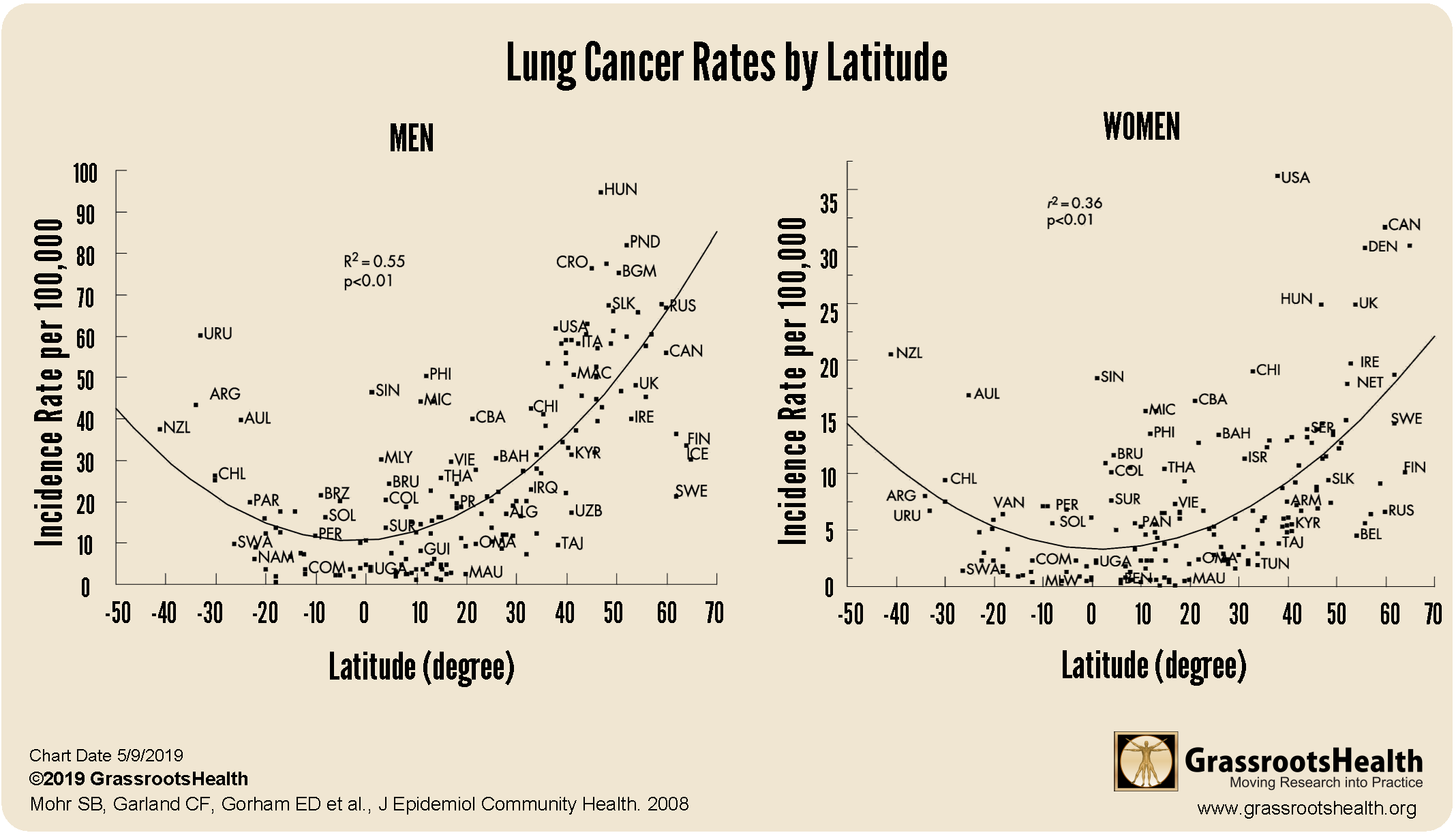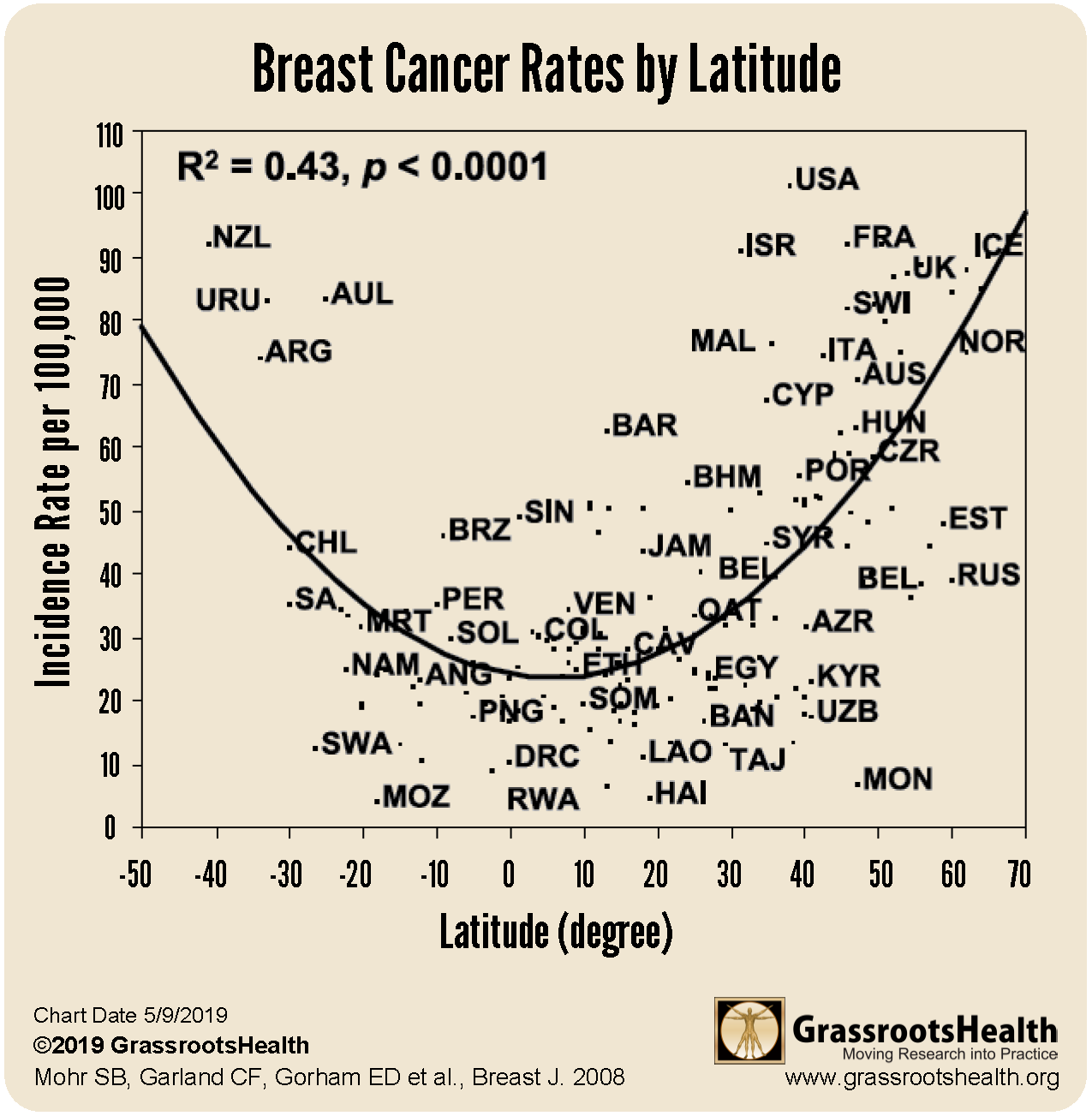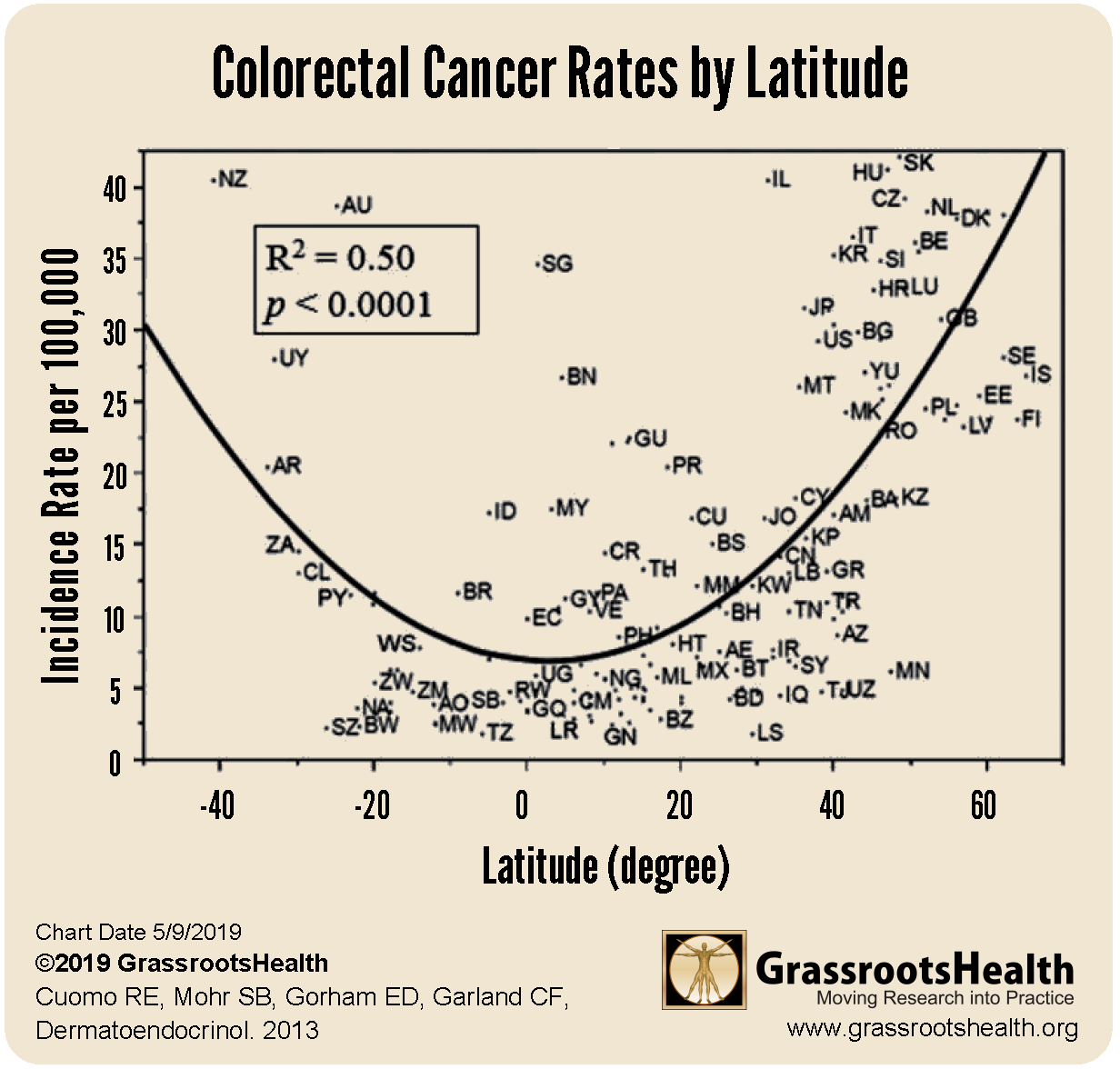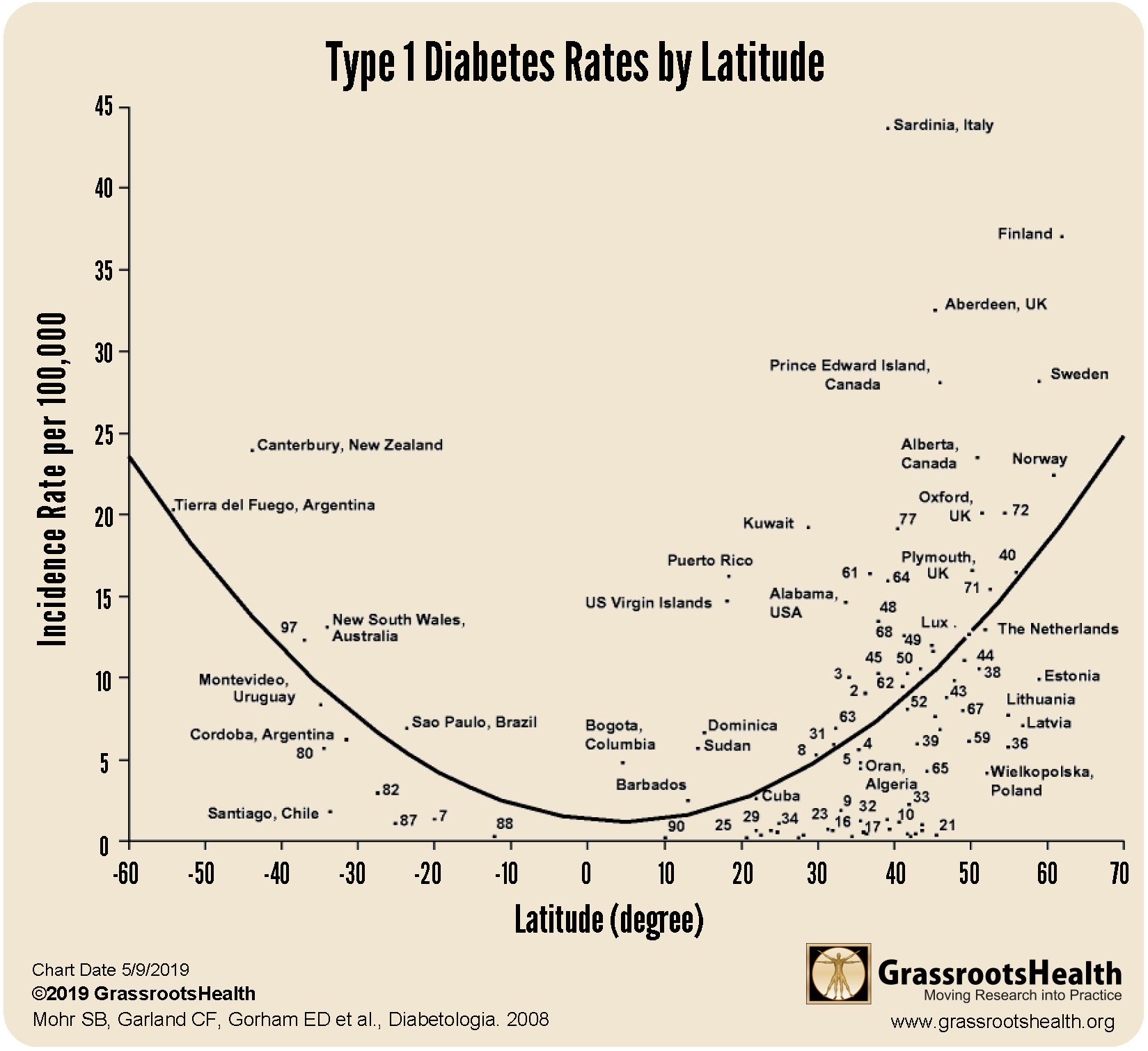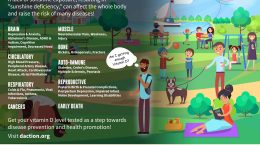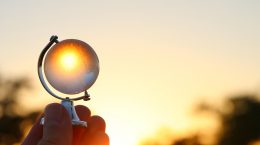Published on May 23, 2022
The repeated pattern in these charts clearly shows the association between latitude, UVB irradiance from the sun, and rates of many cancers and type 1 diabetes
Key Points
- Drs. Cedric Garland and Sharif Mohr, along with others on their research team, have published numerous ecological studies on the association between UVB irradiance and the incidence of many different types of cancer as well as type 1 diabetes. The key figure from these studies is a U-shaped “smiley” curve showing higher disease rates in the far northern and southern latitudes – locations that have lower UVB irradiance from the sun.
- Dr. Garland and his team have published these types of results for lung cancer, breast cancer, colorectal cancer, ovarian cancer, endometrial cancer, renal cancer, bladder cancer, pancreatic cancer, brain cancer, leukemia, and multiple myeloma, as well as type 1 diabetes
- These findings, along with others demonstrating the relationship between sunshine exposure and disease incidence, are a strong indication that increasing sun exposure at a population level may substantially decrease the rates of these diseases
 Drs. Frank and Cedric Garland, both prominent figures in vitamin D and cancer research, were among the first to acknowledge the relationship between geographic location, sunshine exposure, and incidence of cancer. They, with their team of colleagues, published two now famous studies in The Lancet, a well-respected international medicine journal. Both studies showed markedly reduced incidence of colon cancer in populations with the highest intake of vitamin D and the highest serum concentrations of vitamin D. Additional studies describing the relationship between UVB exposure, sunlight, and vitamin D on the incidence of colon, breast, and ovarian cancer have also been published by the Garland brothers, with a recurring theme of decreased cancer risk with increased UVB and vitamin D.
Drs. Frank and Cedric Garland, both prominent figures in vitamin D and cancer research, were among the first to acknowledge the relationship between geographic location, sunshine exposure, and incidence of cancer. They, with their team of colleagues, published two now famous studies in The Lancet, a well-respected international medicine journal. Both studies showed markedly reduced incidence of colon cancer in populations with the highest intake of vitamin D and the highest serum concentrations of vitamin D. Additional studies describing the relationship between UVB exposure, sunlight, and vitamin D on the incidence of colon, breast, and ovarian cancer have also been published by the Garland brothers, with a recurring theme of decreased cancer risk with increased UVB and vitamin D.
Drs. Cedric Garland and Sharif Mohr, along with others on their research team, have since published numerous ecological studies on the association between UVB irradiance and the incidence of many different types of cancer as well as type 1 diabetes. The key figure from these studies is a U-shaped “smiley” curve showing higher disease rates in the far northern and southern latitudes – locations that have lower UVB irradiance from the sun. Countries that are closer to the Equator (presenting in the center of the horizontal axis around the 0 degree latitude) have higher UVB irradiance and tend to have lower disease rates. Following are some of the findings from these studies and their “smiley” curves.
Smiley Curves for Cancer
Lung Cancer
Lung cancer is the most common cancer worldwide and the leading cause of cancer death among men and women in 111 countries (P<0.01). The charts below, one illustrating rates of lung cancer among men and the other for women, show that higher latitude was associated with higher incidence rates of lung cancer among both genders. Additionally, higher UVB irradiance was still associated with a lower risk of lung cancer in both men and women (P<0.01) after adjusting for cloud cover, cigarette use, and other risk factors.
Breast Cancer
A similar pattern has been found for incidence rates of breast cancer, the second most common cancer in the world and the fifth leading cause of cancer death. The chart below shows breast cancer rates were higher in countries with higher latitude across 107 countries (P<0.0001). Also, higher UVB irradiance was associated with lower breast cancer risk (P=0.04) after adjusting for cloud cover and other factors such as alcohol and cigarette use, consumption of animal-based foods, and obesity.
These findings compliment those from other studies showing a reduced risk of breast cancer with increased sunshine exposure overall. One study by Pedersen et al., included data from 38,375 Danish women, 70 years of age or younger, who had been diagnosed with breast cancer, and 191,875 controls who were breast cancer free. They found that long-term occupational UV exposure was associated with a reduced risk of late-onset breast cancer, and that longer durations and higher amounts of UV exposure contributed to a further decreased risk.
Another study by Knight et al. included phone interviews from 972 women who had been diagnosed with invasive breast cancer and 1135 women without cancer. Questions about vitamin D intake, sun exposure, and other breast cancer risk factors were asked for each age group of 10 to 19, 20 to 29, and 45 to 54 years old. The authors found the strongest breast cancer risk reduction among the women with the highest amount of sun exposure and vitamin D intake during the ages of 10 to 19 years old, with a weaker association at 20 to 29 years old and no association for the oldest group. This study indicates that higher amounts of sunshine exposure and vitamin D during adolescence may help prevent the development of breast cancer later in life.
Colorectal Cancer
Rates of colorectal cancer, the third most common cancer worldwide and the second leading cause of cancer death, are higher further from the Equator across 173 countries (P<0.0001). Additionally, higher UVB irradiance was associated with lower colorectal cancer risk (P<0.0001) after adjusting for cloud cover and other relevant factors.
Results from a study on sun exposure and colorectal cancer by Valles et al. further describes a relationship between sun exposure, vitamin D, and colorectal cancer. The study found that people exposed to 2 or more hours of sunshine per day had a 19% lower risk of developing colorectal cancer compared to those who had less sun (P < 0.01). When the researchers analyzed the interactive effects between known risk factors, sun exposure, and dietary intake of vitamin D plus calcium on colorectal cancer, they found both independent and cooperative effects of sun exposure and dietary vitamin D plus calcium on lower colorectal cancer risk. This study shows that sun exposure and dietary vitamin D, both separately and together, could reduce colorectal cancer risk and be key to cancer prevention.
Dr. Garland and his research team have also published similar results for ovarian cancer, endometrial cancer, renal cancer, bladder cancer, pancreatic cancer, brain cancer, leukemia, and multiple myeloma.
Type 1 Diabetes Smiley Curve
Published in 2008, the chart below shows the incidence rates of type 1 diabetes in children aged less than 14 years for 51 regions in the world. Similar to cancer rates shown in the charts above, incidence rates for type 1 diabetes were also higher at higher latitudes and close to zero near the Equator (P<0.001). Dr. Garland and his research team found that higher UVB irradiance, adjusted for cloud cover, was associated with lower incidence rates (P<0.05).
The repeated pattern in these charts clearly shows the association between UVB irradiance from the sun and rates of type 1 diabetes and many cancers. These findings, along with others demonstrating the relationship between sunshine exposure and disease incidence, are a strong indication that increasing sun exposure at a population level may substantially decrease the rates of these diseases.
Make Sure You are Getting Enough Vitamin D TODAY!
 Having and maintaining healthy vitamin D levels and other nutrient levels can help improve your health now and for your future. Choose which additional nutrients to measure, such as your omega-3s and essential minerals including magnesium and zinc, by creating your custom home test kit today. Take steps to improve the status of each of these measurements to benefit your overall health. With measurement you can then determine how much is needed and steps to achieve your goals. You can also track your own intakes, symptoms and results to see what works best for YOU.
Having and maintaining healthy vitamin D levels and other nutrient levels can help improve your health now and for your future. Choose which additional nutrients to measure, such as your omega-3s and essential minerals including magnesium and zinc, by creating your custom home test kit today. Take steps to improve the status of each of these measurements to benefit your overall health. With measurement you can then determine how much is needed and steps to achieve your goals. You can also track your own intakes, symptoms and results to see what works best for YOU.
Enroll in D*action and Test Your Levels Today!


